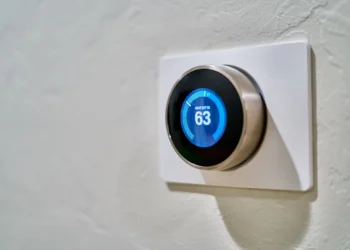Traditional heating, ventilation and air conditioning (HVAC) systems only circulate air and change the temperature. Modern smart models are different. Thanks to the power of the Internet of Things (IoT), they make your HVAC system smarter in ways you wouldn’t believe.
1. Weather Forecast Acclimation
Imagine you’re sitting on your couch, enjoying a show, completely unaware a storm is rolling in. The wind picks up and the temperature drops, but you don’t notice the weather change until you hear the rain begin pelting the window. Why? Because you didn’t have to get up to change the thermostat — your smart HVAC system adapted so you wouldn’t feel the chill.
Internet-connected temperature, humidity, and precipitation sensors can continuously feed data to an advanced algorithm built into your HVAC system, enabling it to acclimate to weather or seasonal changes in real-time. The model adjusts based on your preferences, so you always feel comfortable regardless of how fast the weather takes a turn.
2. Optimized Resource Usage
If you’re like most people, you have a “set it and forget it” attitude regarding your thermostat. In the United States, only 50% of homes are occupied during the day. Moreover, just 42% of homeowners adjust their setpoint temperature when they’re away. This might seem harmless, but it’s not good for your HVAC system — or your wallet.
With a smart HVAC, you never have to think about lowering the temperature before you go and raising it once you return. The system automatically updates based on your schedule. If your system has a companion app, you can see details on how you use electricity to cool or heat your home throughout the day, helping you be more energy-efficient.
3. Zoned Heating and Cooling
Temperature varies based on room positioning. Even if you set your thermostat to 73 degrees Fahrenheit, it might be 69 degrees F in your bathroom and 74 degrees F in the bedroom. The discrepancies are small but noticeable. What’s the point in setting the temperature if it won’t stay consistent?
If you’ve ever had a similar thought, you’re in luck. Zoned heating and cooling is possible with an IoT-enabled HVAC system. You can adjust the temperature in different rooms of your home by controlling the airflow using dampers — motorized devices in ducts that automatically open or close to regulate airflow.
Each zone you create has its own smart thermostat to control the dampers and set the temperature. This way, you can maximize comfort in every room. Best of all, your utility bills lower — and your carbon footprint shrinks — since zoned air conditioning is more energy-efficient than conventional alternatives.
4. Voice Activation and Control
Imagine you’re headed out the door on your way to work. In the doorway, you stop and turn. “I’m leaving now,” you say. “I’ll be back at 6 p.m. sharp.” Who are you talking to? Your voice-controlled thermostat, which is connected to your smart HVAC system. It acknowledges your statement by automatically lowering the temperature to save energy while you’re away.
Many smart thermostats come with basic voice activation and control. What once seemed impossible is now a reality. You can give commands or ask for adjustments based on preset conditions. Whether you have mobility issues or simply aren’t near your control panel when you need to adjust something, these features are incredibly helpful.
5. User Preference Adaptation
If your IoT-enabled HVAC system uses artificial intelligence or algorithm-based technologies, it can adapt to your behavior over time. As a result, its temperature and humidity adjustments will almost always align with your needs. You can finally say goodbye to waking up shivering or entering a veritable sauna when returning home from work.
6. Cellular Connectivity
A companion app lets you monitor and control your HVAC system regardless of location. You can check its status, change the temperature or view its energy usage. Imagine a snowstorm hits while you’re away for the holidays. Thanks to cellular connectivity, you can turn on the heat to keep your pets comfortable and pipes from freezing even from hundreds of miles away.
Geofencing — a virtual boundary in a real-world location — is a lesser-known benefit of cellular connectivity. It triggers a predetermined action when you enter or exit the preset area. For example, you could set it to turn your heat or air conditioning on when you get within five miles of your home.
7. Preventive HVAC Maintenance
You need to change, clean or check on many HVAC parts periodically. According to the United States Department of Energy, you should clean air filters at least once a month and replace them regularly to keep your system performing at peak efficiency. How often do you actually do that? Unfortunately, it’s easy to forget.Thankfully, with an IoT-powered HVAC, you don’t have to try remembering — your system does that for you. Strategically placed fluid, gas and air quality sensors can automatically send alerts to your phone or thermostat display when it’s time to replace or fix something. For example, it can warn you of a refrigerant leak.
The Most Exciting Features Are Yet to Come
You have to admit — smart HVAC systems live up to the name. It’s almost difficult to comprehend how an uninteresting, overlooked system like this has become so cutting-edge and exciting. Who knows how this technology will evolve alongside the IoT?









